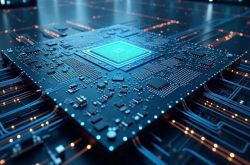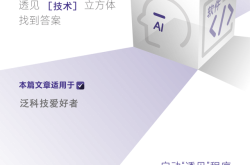Industry | From WAIC 2025: The Race for Computing Power Intensifies, with Large Models Striving for Real-World Applications
![]() 08/08 2025
08/08 2025
![]() 502
502
Preface: Last year, the AI field's investment focus was still centered on the arms race for computing power, with large model companies and tech giants pouring massive funds into purchasing hardware to enhance model performance. However, as the industry matures this year, the core metrics for investment evaluation have shifted, with business value dimensions such as order growth rate, gross margin, task execution efficiency, and return on investment becoming increasingly crucial. The procurement by these cost-sensitive manufacturing giants signifies that humanoid robots are transitioning from luxury display items to consumer products that address real needs, beginning to generate real economic value.
Author | Fang Wensan
Image Source | Network
Computing Power Inflection Point: Domestic Breakthroughs and Super-Node Efficiency Enhancements
With the widespread adoption of applications such as large model training, intelligent interaction, and edge AI across various industries, the demand for computing power at different levels continues to surge.
In the realm of edge AI, domestic chips are making breakthroughs by boosting the performance of individual chips.
While pursuing extreme performance sets an upper limit for the computing power competition, gaining deep insights into diverse application scenarios broadens the scope of this competition.
Market demand is evolving rapidly, presenting two major trends:
- Due to data security concerns, enterprises' demand for privatized deployment of large models continues to rise.
- Training and inference scenarios are gradually separating, with different applications requiring cost-effective computing power solutions.
The super-node architecture has emerged as the core pathway for domestic computing power to achieve large-scale breakthroughs.
Its rise indicates that the gap in single-chip technology for domestic computing power can be bridged through system design, achieving cluster efficiency beyond that of traditional architectures.
This adaptive improvement for AI scenarios marks a crucial step in the transition from stacking computing power to practical capabilities.
Computing Power Products: Multi-Dimensional Innovation Results Concentrated Display
At this year's WAIC exhibition, multiple companies showcased their latest computing power products, spanning the entire chain from chips, graphics cards, to cluster systems.
Huawei exhibited the Atlas 900 A3 SuperPoD super-node cluster, which, based on the super-node architecture, comprises 12 compute cabinets and 4 bus cabinets, integrating 384 Ascend 910 NPUs and 192 Kunpeng 920 CPUs, making it the largest super-node system in the industry to date.
Moore Threads displayed its full-featured GPU chips and a series of application products, including the MTT S80 gaming graphics card and MTT S3000/4000 smart computing center graphics cards.
Its product line achieves a comprehensive layout from chips to graphics cards to clusters, supporting composite workloads such as AI computing acceleration, 3D graphics rendering, ultra-high-definition video codec, and scientific computing.
MXI's exhibition adopted a three-dimensional approach, showcasing products ranging from single chips to large high-density computing power cabinets and cooling systems.
Its newly released XiYun C600 GPU chip is designed and manufactured based on the domestic supply chain and completed tape-out in July this year.
This chip adopts a self-developed GPGPU architecture and instruction set, possessing both general-purpose computing and intelligent computing capabilities, with a high degree of autonomy.
The high-density computing power POD displayed on-site integrates AI energy management, GPU computing efficiency optimization, cold-plate liquid cooling, and flexible power distribution solutions, supporting flexible expansion of 8 to 128 computing devices.
Suiyuan Technology brought the S60 AI inference acceleration card and the DeepSeek all-in-one prototype.
The S60 is designed for large-scale deployment in data centers and has been applied to the AI outfit function of Meitu and the inference cluster of Qingyang Smart Computing Center.
Tests show that the S60's inference latency is on par with overseas products of the same level and offers significant cost-performance advantages at BF16 precision.
The Qingyang 10,000-card S60 cluster has been open to external inference computing power services since January 2025.
Myriad AI exhibited the high-performance programmable chip Antoum, which supports a 32x sparsity rate. This chip is compatible with mainstream models such as CNN, RNN, Transformer, and various data types, achieving breakthrough improvements in codec performance in visual applications.
CloudMinds launched the fully self-developed DeepEdge10 series chips, pioneering the [computing power building block] structure based on domestic technology.
Post-Moore Intelligence released the end-edge large model AI chip Post-Moore Manjie M50, capable of running local models with parameters ranging from 1.5B to 70B under high efficiency.
CiXin Technology's CiXin P1 chip has also made significant progress, providing 45 TOPS end-side computing power, offering strong support for edge AI.
For large AI infrastructure, the industry is shifting from chip stacking to system construction, employing [super-nodes] to expand efficiency boundaries.
Super-nodes form larger-scale computing units by integrating multiple servers and multiple computing power cards, breaking through traditional deployment limitations.
This aggregation is not a simple hardware stack but optimizes technologies such as intra-node interconnection and liquid cooling to enhance cluster energy efficiency, communication bandwidth, and space utilization, specifically addressing complex large model AI tasks.
ZTE launched the LightSphereX solution, the world's first distributed optical interconnect optical switching GPU super-node.
It is based on the distributed optical switching technology of Lightelligence, combined with silicon photonics chips, the high-computing power GPU liquid cooling module of Moore Threads, and equipped with ZTE AI servers and Yidian Smart Computing Cloud software, to construct a high-bandwidth, low-latency, and scalable autonomous smart computing cluster.
Shenzhou Digital's Shenzhou KunTai launched the industry's first KunTai R624K2 large model training and inference integrated server and KunTai R622K2 inference server based on Kunpeng technology at the conference.
The KunTai R624K2 supports up to 10 mainstream AI acceleration cards, with computing performance doubled compared to its predecessor; while the KunTai R622K2 achieves the industry's highest computing power density within a 2U space.
Large Model Applications: From Parameter Competition to Deep Industrial Integration
In 2023, over 20 robots debuted for the first time; in 2024, 18 humanoid robots were showcased in a matrix; this year, the number of intelligent robots exhibited increased to over 60 models, with the total number of humanoid robots reaching over 150.
This year's WAIC comprehensively released the key signals of the AI era through in-depth analysis of large model technology paths and exploration of the AI legal system, advancing on multiple fronts.
Large language models understand language like multi-dimensional LEGO bricks, with each word representing a multi-dimensional feature set.
This deepening understanding is driving the global AI industry to transition from a mere parameter competition to a new stage that places greater emphasis on creating real value.
At WAIC 2025, various vendors launched AI new products to showcase their strategic directions. These developments are not limited to routine iterations at the technical level but also reveal a fundamental shift of AI from an auxiliary tool to a core element of industries.
From the practical application of embodied intelligence to the in-depth expansion of AI agent functionality, to significant strides in computing power and model innovation, AI is comprehensively penetrating the underlying architectures of various industries, reshaping industrial operational logic and development paths.
Model vendors are collectively shifting from the cloud to actual industries, bidding farewell to mere parameter competition and technology demonstrations, delving into the core of industries, exploring application scenarios, building ecosystems, and embarking on the journey of technology commercialization.
The deep integration of models and industrial scenarios is crucial because only in real-world environments can AI obtain novel, high-quality data imbued with physical laws, driving evolution to higher dimensions.
The industry has entered a new stage of returning to customer needs and taking root in practical application scenarios.
Observing market progress, the ultimate form of large models still has a long way to go. As open-source and closed models converge in performance, it is difficult to achieve significant differentiation in the domestic market based on models alone; therefore, accurately identifying one's own industrial niche becomes particularly crucial.
WAIC 2025 Releases Three Major Industrial Trends
WAIC 2025 sends a clear signal: AI is breaking through the limitations of symbolic instructions and deeply integrating into segmented scenarios through embodied carriers. Behind the exhibition's heat, three major AI industry trends are gradually becoming clear:
- Model development shifts towards pursuing ultimate [inference efficiency]: Parameter scale competition gives way to efficiency optimization, with diminishing marginal returns from Scaling Law driving the industry to focus on [low-cost, high-concurrency] inference solutions.
- Alibaba open-sourced three new models: Qwen3's inference model performance is on par with Gemini 2.5 Pro; Qwen3-Coder topped the HuggingFace overall ranking, driving API calls to exceed 100 billion tokens in three days.
- SenseTime released the Ririxin V6.5 multimodal large model, natively integrating perception and navigation capabilities, with a 35%+ increase in inference throughput, multimodal performance surpassing GPT-4o and Gemini 2.5 Flash, achieving a 5x leap in cost-effectiveness.
- Step Star introduced the Step3 series of models, achieving 300% of the inference efficiency of DeepSeek-R1 on domestic chips.
- Computing power upgrades evolve into system-level [super factories]: Combinations of technologies such as MoE architecture, mixed precision, quantization pruning, and real-time scaling (Test-Time Scaling) drive models to achieve [on-the-fly computation during inference], obtaining higher accuracy with lower computing power.
- Application scenarios extend to the physical world for [autonomous execution]: The core of market competition in the next two years lies in who can deliver superior performance within the same computing power budget, as they will grasp the initiative in the industry.
Conclusion:
It is evident from the many developments at WAIC 2025 that the AI industry is undergoing a crucial transition from technological enthusiasm to rational implementation.
The competition for computing power is no longer merely about stacking performance but finding a precise balance between efficiency, cost, and security through super-node architectures, domestic chip breakthroughs, and scenario-based solution design.
Large models have also bid farewell to the era of [parameters reign supreme], instead delving deep into industrial scenarios with the core goals of improving inference efficiency, constructing niches, and creating real value.
Partially referenced materials:
- Mirror Image Studio: "At WAIC, people want to know more about how to make money with AI than watching robots box"
- Top Tech: "Domestic AI computing power takes off against the wind, making major breakthroughs in various technological paths"
- Economic Observer: "WAIC 2025 Observation: Computing Power Competition Escalates, Models Seek Paths to Real-World Applications"
- Caijing: "WAIC 2025 Closes: Expected Visitor Count Exceeds 350,000, Investment Exceeds 15 Billion"
- IoT Think Tank: "WAIC 2025: From Technological Breakthroughs to In-depth Scenario Applications, AI Practice Begins to Cross Three Major Inflection Points"






